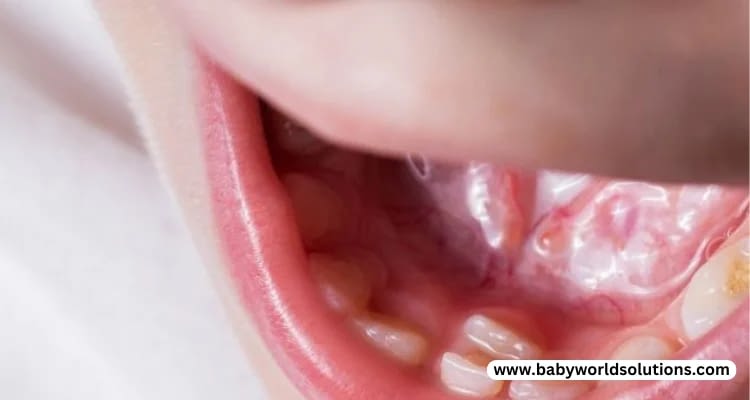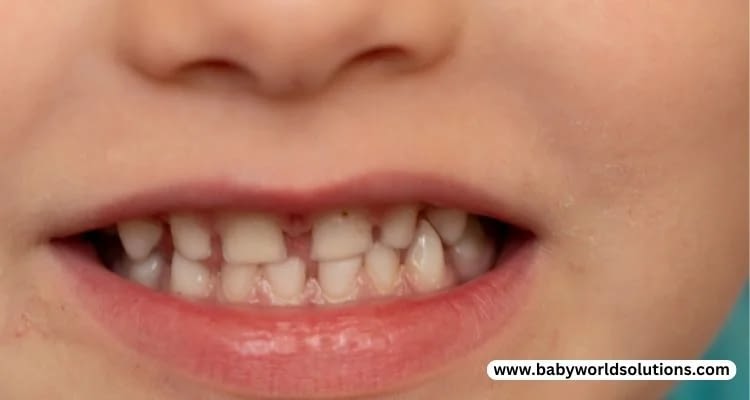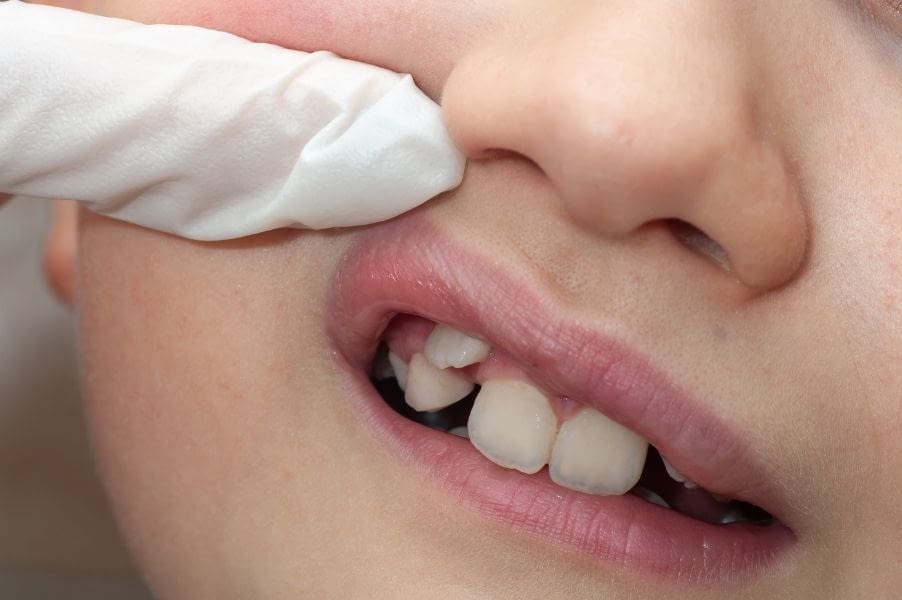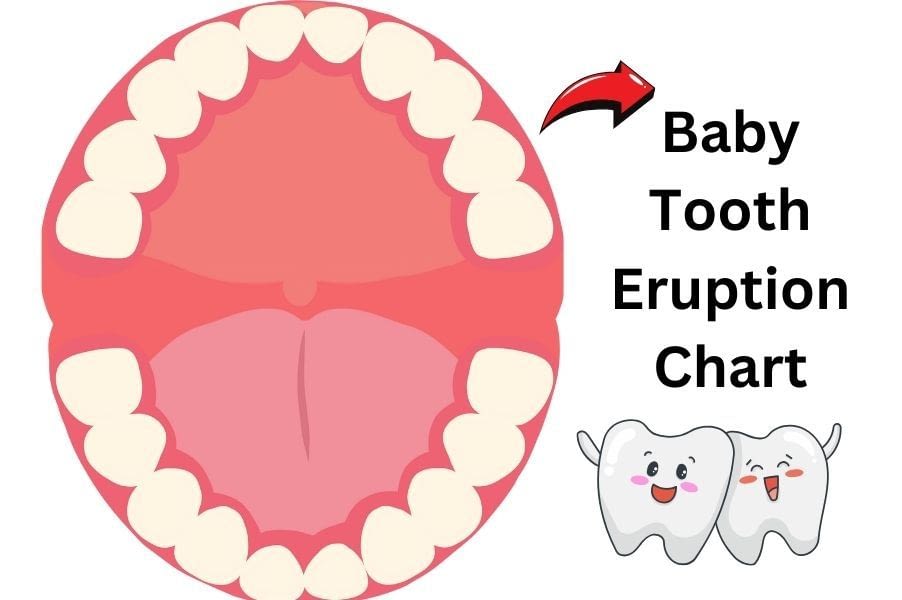Welcoming a new baby into your family brings indescribable joy, accompanied by many hopes, dreams, and questions—particularly about their growth and development. One common concern that new parents often face is their infant’s oral care, especially when it seems like their baby’s teeth are coming out of order.
Rest assured, you are not alone in this worry, and this guide is designed to navigate the nuances of baby teeth development, address common concerns, and equip you with the knowledge needed to ensure your child’s smile blossoms beautifully.
As first-time parents, the emergence of each tiny tooth can feel as momentous as the moon landing. However, the process can sometimes be textbook perfect, leading to undue stress. Let’s delve into the timeline of tooth eruption order and why those pearly whites popping up in unexpected sequences are generally nothing to fret over.
Understand why baby’s teeth coming in wrong order
Baby teeth, also known as primary teeth, are the first set of teeth that children grow, and they are important for their early development. They pave the way for future dental health and assist in speech development and proper nutrition through chewing.
The primary teeth eruption process typically begins around six months of age, although it may start as early as four months or as late as twelve. By age three, most children will have a complete set of 20 baby teeth. The standard order of appearance begins with the bottom front teeth, followed by the top front teeth.Next come the lateral incisors, first molars, canines, and second molars.
Despite these general patterns, variations occur, and it is perfectly normal for some babies to deviate from this order. What’s important is that the teeth eventually come in and are healthy.

Expert insights on teething
“Teething is a complex process and varies significantly among children. Parents should be vigilant but not overly concerned about the order in which baby teeth appear,” explains Dr. Sarah Park, DDS, a pediatric dentist. “However, if a child shows no signs of teething by 15 months, it’s worth discussing with a healthcare provider.”
“Despite the typical teething age and order, I see many healthy variations in my practice,” says Dr. Andrew Howard, DDS. “It’s essential for parents to focus on creating a positive oral hygiene routine that will benefit the child’s teeth regardless of the order in which they appear.”
Stages of Tooth Eruption
Tooth eruption is a process that typically begins in infancy and continues through early childhood. It involves the movement of teeth from their developmental position within the jaws to their functional position in the oral cavity. This process occurs in stages, each associated with specific developmental milestones.
- Pre-eruptive Stage: This stage begins in the womb, with the initial formation of tooth buds. The tooth is developing but has not yet started to move towards the oral cavity.
- Eruptive Stage: During the eruptive stage, the tooth moves upward (or downward, in the case of lower teeth) and breaks through the gum. This is the stage commonly associated with teething.
- Post-eruptive Stage: The post-eruptive stage begins once the tooth has fully erupted and is in position. During this stage, the tooth will continue to change in response to wear, shifting of other teeth, and the overall growth of the jawbone.
Sequence of Primary Teeth Eruption
The sequence of primary teeth eruption, deciduous or baby teeth, occurs in a fairly predictable pattern. Here’s a general timeline:
- Central Incisors: The central incisors, or front teeth, generally erupt first, typically around 6-10 months of age.
- Lateral Incisors: These teeth are next to the central incisors and usually erupt between 10-16 months.
- First Molars: The first molars erupt behind the incisors, generally between 13-19 months of age.
- Canines: The canines, or eye teeth, typically erupt between 16-23 months of age.
- Second Molars: The second molars, located at the back of the mouth, are usually the last to erupt, typically between 23-33 months.
Factors Affecting Tooth Eruption Order
Several elements can influence how and when baby teeth appear, including:
Genetic Factors
Just as genes determine hair color and height, they also impact teething patterns. If you or your partner had teeth that emerged in a unique order, your baby could follow suit.
Individual Variations
Each infant is a world unto themselves, and their development, including teething, can vary widely. These variables are typically no cause for concern.
Other Underlying Conditions
In rare cases, alterations in tooth eruption could be signs of underlying medical conditions. If you notice any other developmental concerns, discussing them with a healthcare professional is always prudent.

Common Misconceptions and Concerns
Teeth Coming in Out of Order
It is not uncommon for baby teeth not to arrive in pairs or lateral incisors to emerge before central ones. These irregularities are part of the child’s unique growth process and rarely indicate a problem.
Delayed Eruption
Some babies may get a late start on teething. While parents eagerly anticipate each new tooth, remember that a delay isn’t necessarily alarming. Genetics and individual growth rates often explain these variations.
Do 4 year olds get molars? In general, children begin to get their first molars around the age of 6, but there can be variations. If a 4-year-old has molars, it might be their ‘first molars’, commonly known as ‘6-year molars’, coming in early. However, it’s not typically a cause for concern unless accompanied by pain or discomfort.
Do 7 year olds get molars? Around the age of 6 to 7, children commonly get their first molars, also known as ‘6-year molars’. These teeth erupt behind all the baby teeth and are part of the permanent set. If your 7-year-old is getting their first molars, it’s a regular part of their dental development.
Gaps Between Teeth
Finding spaces between your baby’s new teeth can be disconcerting, but gaps often provide room for more prominent permanent teeth later.
A tooth growing in front of another tooth
Occasionally, a new tooth may appear in front of another, causing concern. In most cases, this is not a problem and can be easily corrected by an experienced dentist.
Baby has 4 teeth coming in at once
It may seem like a lot for your little one to handle, but don’t worry; this is not uncommon. As the eruption process typically spans 2-3 years, multiple teeth would appear at once.
Baby getting vampire teeth first.
Suppose your child’s upper canines emerge before their incisors. In that case, they may seem to have “vampire teeth.” However, this is entirely normal and does not affect the overall development of the permanent teeth.
A child’s bottom teeth grow behind another.
Sometimes, a child’s permanent teeth start to grow in before the corresponding baby teeth have fallen out, leading to a phenomenon often referred to as ‘shark teeth’. While it can look alarming, it’s relatively common and usually resolves as the baby’s teeth eventually fall out. However, if the baby’s teeth don’t loosen despite the growth of the permanent teeth, it’s advised to consult a dentist for further evaluation.
Tips for Promoting Healthy Teeth Development
To ensure your baby’s teeth are healthy—regardless of their order—consider the following:
Proper Oral Hygiene Practices
It’s important to clean your baby’s gums even before the first tooth appears. Use a soft cloth to clean their gums after each feeding. Once the first tooth appears, practicing good oral hygiene becomes even more crucial. Wipe the tooth with a clean and damp cloth after feedings and before bed. As more teeth come in, switch to an infant or toddler-sized toothbrush with soft bristles.
Only use fluoride toothpaste once cleared by a dentist. However, proper care is vital as the primary teeth are crucial in maintaining space for future permanent teeth.
Regular Dental Check-ups
Infant oral care should include regular dental visits. The American Dental Association recommends that a child’s first dental visit occur within six months following the first tooth’s arrival and no later than the child’s first birthday. Regular dental checkups will allow for early detection and prevention of potential problems.
Balanced Diet and Nutrition for Healthy Teeth
A diet rich in calcium, phosphorus, and vitamins A and D is crucial for the development of strong teeth. Breast milk, formula, and water are the best beverages to serve in bottles. Avoid sugary drinks, which can contribute to tooth decay.
When to Consult a Dentist
Be on the lookout for the following signs that might signify potential issues:
- Teeth that remain unerupted well beyond expected timelines.
- Discoloration or pitting of baby teeth could suggest enamel hypoplasia or other dental conditions.
- Teething discomfort that seems excessive or is not soothed by standard teething remedies.
Importance of Early Intervention
Early intervention can prevent or mitigate dental problems. Reach out to your dentist if you come across anything unusual. Early dental care can help establish beneficial lifelong oral hygiene habits.
Conclusion: Baby’s teeth coming in wrong order
As a new parent, it’s natural to fret over every milestone and compare notes with fellow caregivers, hoping your bundle of joy is on the right track. Remember that baby teeth development is a marvel of biology with a unique rhythm for each child. The eruption of baby teeth out of order is often just a quirk and nothing to lose sleep over. Instead, focus on nurturing your child’s oral hygiene and overall health.
Encourage regular dental check-ups and practice diligent tooth care at home. Not only will you alleviate potential concerns about teething orders, but you’ll also lay down the foundation for a lifetime of healthy smiles for your child. And if doubts persist, your pediatric dentist is just an appointment away, ready to provide professional insights and peace of mind. Remember, the most crucial aspect isn’t when the teeth arrive but that they are cared for lovingly when they do!
Your child’s journey through teething and beyond is one you’ll recount with a mix of awe and nostalgia in years to come. So take a deep breath, continue to chart their progress, and revel in each tiny tooth—as it’s just one of many milestones that make up the wondrous tapestry of parenthood.
Parents Also Ask
How long do canine teeth take to come in?
The eruption of canine teeth, also known as cuspids or “eye teeth,” usually occurs between 16 and 23 months of age. However, the entire process can take several months, from when the tooth breaks through the gum until it has fully come in.
What 7 year old hasn’t lost any teeth?
Children typically begin losing their baby teeth around age 6, although the timing can vary significantly. If a 7-year-old has yet to lose teeth, they may be late to the party. However, if your child reaches the age of 8 without losing any teeth, it may be worth consulting with a pediatric dentist to rule out any potential issues.
What If the baby gets upper teeth first?
While the lower central incisors are generally the first to appear, it’s not uncommon for a baby to get their upper teeth first. The tooth eruption process can vary greatly from child to child.
2 Visits today





